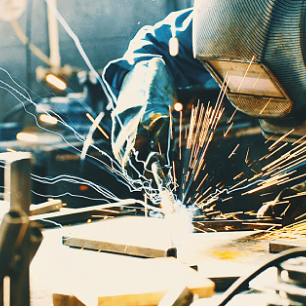Jump to:
How to Correctly Use Welding Symbols for Slotted Hollow Structural Steel Members
AWS A2.4:2020, Standard Symbols for Welding, Brazing, and Nondestructive Examination, provides the tools needed to facilitate communication between the designer, welder, and inspector about the requirements for a given weld. These symbols and the rules and conventions for their application are widely understood and utilized across the welding industry. In some instances, however, careful thought is required to ensure that the symbol used is correct for the weld detail required. The confusion may lie not in the welding symbol itself but in applying the arrow side-other-side convention, which is critical for properly understanding where the weld specified by the weld symbol should be placed on the joint.
AWS A2.4:2020, Clause 6.1, states, “Information applicable to the arrow side of a joint shall be placed below the reference line. Information applicable to the other side of a joint shall be placed above the reference line.” Figure 1 illustrates this convention.
Welding industry professionals are likely familiar and comfortable with this concept. Once understood and with a bit of experience, it becomes intuitive to look at a symbol and, based on the orientation of the symbol relative to the joint and on which side of the reference line information is placed, visualize how the joint is to be prepared and the weld completed. Still, on occasion, a situation arises that causes even experienced personnel to misunderstand the application of these conventions. One such example is addressed in this article.
Misunderstood Applications
In structural steel design, a common detail is to have a hollow structural steel tube slotted to accept a plate gusset, which is then attached to the larger structure — Fig. 2. This slotted tube is typically welded with fillet welds on the exterior of all four areas where the tube wall contacts the gusset plate. When employing symbols to communicate this requirement, it may seem natural to use double fillet weld symbols to indicate a fillet weld is required on each side of the gusset plate. However, this is an incorrect application of the symbol and, if interpreted correctly by the welder, will result in a much different weld configuration than desired (should it even be physically possible to complete).
It is emphasized that AWS A2.4 states that information applies to the arrow side and the other side of the joint. To understand exactly what constitutes the joint, we look at the information provided in AWS A3.0M/A3.0:2025, Standard Welding Terms and Definitions. This defines a joint as “the junction of workpiece(s) before and after joining” and further references Figs. B1 and B2; illustrations from A3.0 Fig. B1 are reproduced in Fig. 3.
Note that the area defined as the joint is shaded in these figures. In every case, there is a surface of one member of the joint bearing on a surface of the other member and a path from one side of the joint to the other, which includes one surface from each member. When applied to a common T-joint, the location of the joint itself, and thus the applicability of information shown on the welding symbol, is clear — Fig. 4.
When a second T-joint is added to the opposite side of the horizontal member (Fig. 5), two distinct joints are created, here designated Joint A and Joint B. The welding symbol, whose arrow points only to Joint A, only applies to Joint A and calls for a fillet weld to be applied to both sides of the joint.
The same is true when multiple joints are on the same side of the member, as is the case with the formed channel illustrated in Fig. 6. Each leg of the channel forms a distinct joint, and a welding symbol specifying a double fillet weld on one of the joints calls for a fillet weld to be applied to each side of that joint only.
If a fillet weld is desired on the outside of each leg of the channel, a separate single fillet symbol is required for each leg — Fig. 7.
Combining these concepts, we have the case of the slotted hollow structural tube welded to a plate. In this case, if the designer uses a double fillet symbol, as shown in Fig. 8, what is actually being called for is a fillet on the outside and inside walls of the tube.
If a weld is desired between the outside wall of the tube and the plate on both sides of the plate, again separate welding symbols must be used — Fig. 9.
If a weld on the exterior of all four walls of the tube is required, four separate single fillet symbols are used to communicate this — Fig. 10. Keep in mind that it may not be necessary to use symbols to indicate every weld required; notes in the tail of the symbol or other drawing notes may also be used to communicate these requirements.
Conclusion
Starting from the first principles and the simple example of a standard T-joint, it becomes clear how to properly interpret the joint and apply the correct welding symbols on a slightly more complex configuration. This common misunderstanding is a reminder that while much of the use of welding symbols becomes second nature with experience, the designer must always be aware of the fundamental requirements and that what may seem like the obvious application is not always correct.
CHRIS THUROW, PE (christopher_thurow@hsb.com) is vice chair of the AWS A2 Committee on Definitions and Symbols and chair of the A2C Subcommittee on Symbols. He is an AWS CWEng and SCWI and an authorized nuclear inservice inspector at The Hartford Steam Boiler Inspection and Insurance Co., Hartford, Conn.


